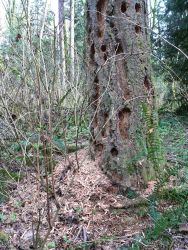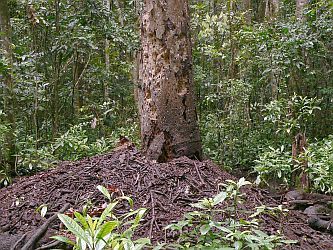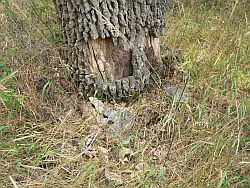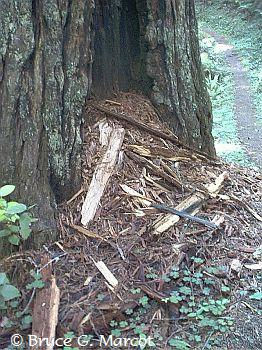|
Explanation:
Three trees. With the bark stripped. And cavities. Where are
we? And who made these? We
are looking at what can be termed the results of functional vicariates
-- that is, very similar ecological roles ("key
ecological functions") played by very different animals in different
ecosystems.  On
the left is a Douglas-fir
tree (Pseudotsuga menziesii) in a state
park in Oregon, USA. The cavities and wood chip pile were
made by a foraging Pileated
Woodpecker (Dryocopus pileatus), the largest woodpecker of the
region. Pileated Woodpeckers serve as a primary
cavity excavator, creating tree hollows for feeding and nesting, in which
many other species (secondary cavity users) can take residence. The bark
and wood chip pile at the base of the tree is used by other species including
clouded salamanders, snakes, lizards, and invertebrate prey. On
the left is a Douglas-fir
tree (Pseudotsuga menziesii) in a state
park in Oregon, USA. The cavities and wood chip pile were
made by a foraging Pileated
Woodpecker (Dryocopus pileatus), the largest woodpecker of the
region. Pileated Woodpeckers serve as a primary
cavity excavator, creating tree hollows for feeding and nesting, in which
many other species (secondary cavity users) can take residence. The bark
and wood chip pile at the base of the tree is used by other species including
clouded salamanders, snakes, lizards, and invertebrate prey.
 In
the center is a Rockingham
candlenut tree (Aleurites rockinghamensis) in a semi-deciduous
forest near Wongabel, northern Queensland, Australia. The cavities and
wood chip pile were made not by a bird (there are no woodpeckers in Australia)
but by a Striped
Possum (Dactylopsila trivirgata), an uncommon marsupial locally
endemic to the rainforests and woodlands of the region. It
excavated this tree in search of wood-boring grubs to eat. The cavities
can be inhabited by parrots and other birds of the area. The bark and
wood chip pile here has been further scraped into a nest mound by an Australian
Brush-turkey (Alectura lathami), which is not
a true turkey but rather one of the species of megapode. In
the center is a Rockingham
candlenut tree (Aleurites rockinghamensis) in a semi-deciduous
forest near Wongabel, northern Queensland, Australia. The cavities and
wood chip pile were made not by a bird (there are no woodpeckers in Australia)
but by a Striped
Possum (Dactylopsila trivirgata), an uncommon marsupial locally
endemic to the rainforests and woodlands of the region. It
excavated this tree in search of wood-boring grubs to eat. The cavities
can be inhabited by parrots and other birds of the area. The bark and
wood chip pile here has been further scraped into a nest mound by an Australian
Brush-turkey (Alectura lathami), which is not
a true turkey but rather one of the species of megapode.
 On
the right is an Oregon
white oak (Quercus garryana) along the Columbia River Gorge east of
the crest of the Cascade Mountains in eastern Oregon. The bark has been
chewed and fragmented by foraging Black-tailed
Deer (Odocoileus hemionus). The loose bark on the tree can be
used as roosting sites by bats,
salamanders, snakes,
and other species, and the bark chip pile can hide reptiles and
amphibians. On
the right is an Oregon
white oak (Quercus garryana) along the Columbia River Gorge east of
the crest of the Cascade Mountains in eastern Oregon. The bark has been
chewed and fragmented by foraging Black-tailed
Deer (Odocoileus hemionus). The loose bark on the tree can be
used as roosting sites by bats,
salamanders, snakes,
and other species, and the bark chip pile can hide reptiles and
amphibians.
So here we see three different forest ecosystems
with vastly different species each performing the same key
ecological function of cavity excavation and bark-pile formation, with
different sets of other wildlife species that secondarily use the cavities,
loose bark, and bark and chip piles. There are many other species in
other forests of the world that also perform these primary key ecological
functions. It is very interesting to focus on the functions and see how
different ecosystems can be so similar!
-
- - - - - - - - - Bonus
photo: another forest ecosystem, tree species, bark pile, and associated wildlife species! Here is a coast
redwood (Sequoia sempervirens) in Prairie Creek Redwoods State Park
in northern California. The bark and the wood beneath has been shredded
probably by woodpeckers and other animals or naturally sloughed off. It
has been gathered and piled here by a dusky-footed
woodrat (Neotoma fuscipes) which is native to the area and which
creates middens or nests of piles of wood and other material. Not
just that, but many other animals use woodrat nests, such as kingsnakes.
associated wildlife species! Here is a coast
redwood (Sequoia sempervirens) in Prairie Creek Redwoods State Park
in northern California. The bark and the wood beneath has been shredded
probably by woodpeckers and other animals or naturally sloughed off. It
has been gathered and piled here by a dusky-footed
woodrat (Neotoma fuscipes) which is native to the area and which
creates middens or nests of piles of wood and other material. Not
just that, but many other animals use woodrat nests, such as kingsnakes.
So here is a remarkable linkage between tree, birds, rodents, snakes, and other species.
This is not a food web; it is what I call a functional web.
|
